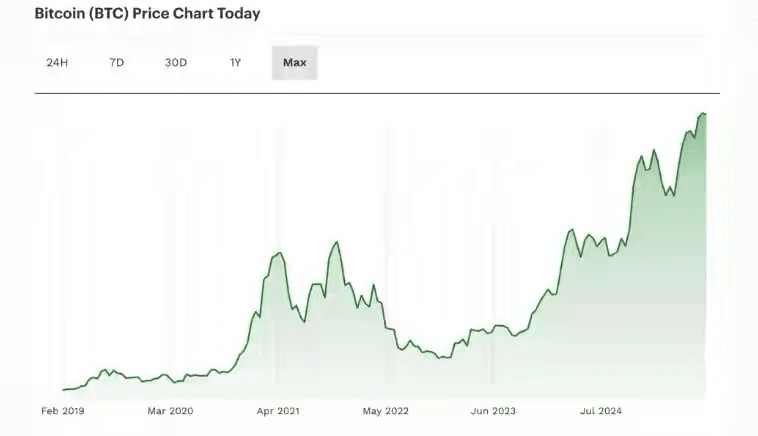Bitcoin prices have soared this year, surpassing the explosive gains of Wall Street's entry into the cryptocurrency space in 2024—although some predict that the Bitcoin price bull market may just be beginning.

Since this time last year, Bitcoin prices have doubled, and the cryptocurrency market looks “strikingly similar” to last summer's surge in Bitcoin and other major cryptocurrencies like Ethereum and XRP.
Now, with JPMorgan suddenly reacting to factors that could change Bitcoin prices, U.S. President Trump has signed an executive order that will make it easier to include Bitcoin, cryptocurrencies, and other alternative assets like private equity and real estate in 401(k) retirement accounts, which total $12.2 trillion.
A White House briefing stated: “Alternative assets such as private equity, real estate, and digital assets provide competitive returns and diversification advantages.”
Trump's signing of this long-rumored executive order boosted Bitcoin prices, allowing it to break the $120,000 mark for the first time since last month, while Ethereum soared 21% this week, surpassing $4,000 for the first time since last December.
XRP is one of the best-performing major cryptocurrencies over the past year, with an increase of nearly 500%, up 12% this week, helping the total crypto market cap surpass $4 trillion.
Anthony Agoshkov, co-founder of Marvel Capital, commented in an email: “This could mark a significant milestone in introducing digital assets into mainstream financial infrastructure, opening the door for long-term adoption by average Americans.”
The order requires the Labor Department 180 days to review the rules, and any changes are not expected to show immediately in the Bitcoin and cryptocurrency markets.
Katalin Tischhauser, head of research at Sygnum Bank, stated via email: “Trump's executive order has opened the door to incorporating cryptocurrencies and private assets into 401(k) retirement plans, paving the way for more options and providing investors with greater choices.”
“This is another bullish driver for the cryptocurrency market, as relatively small market caps mean capital flows can have a significant impact on prices.”
In May of this year, the U.S. Department of Labor rescinded its 2022 guidance that urged any investment company to be “extremely cautious” before adding cryptocurrencies to retirement account options.
Joel Kruger, market strategist at LMAX Group, commented in an email: “This statement has sparked optimism about future institutional capital inflows, especially considering the total size of the U.S. fixed contribution market is about $10 trillion.”
“Washington is forming a more favorable regulatory tone. Trump's executive order was issued after lawmakers sent a series of signals aimed at establishing clearer guardrails for the classification and access of digital assets.”
While there is currently no prohibition on retirement plan operators increasing these types of investments, the order is expected to bring more diverse options to people.
Matt Hogan, CIO of Bitwise, stated in an email: “This order is not the government saying ‘cryptocurrencies should be included in 401(k) plans,’ but rather the government should step back and let people make their own decisions.”
Following Trump's cancellation of Wall Street's cryptocurrency restrictions from the Biden era, Trump's order to establish Bitcoin strategic reserves and cryptocurrency inventories (expected to include Ethereum and XRP, among others), as well as the passage of the (Genius Act) stablecoin legislation, the latest bullish signals from the Trump White House are helping to “shift trader sentiment,” but have yet to translate into meaningful price movements.
Markus Thielen, founder of 10x Research, stated in an email: “Trump's latest moves—from expanding the use of cryptocurrencies in 401(k) plans to shining a light on gold—could change market sentiment, but so far, the reaction has not been strong.”
Meanwhile, Ethereum's address activity and price have reached all-time highs, but this trend seems largely driven by narratives rather than fundamentals. Both assets are currently facing pressure at critical technical boundaries, and their upward momentum could accelerate or come to a sharp halt.
Bitcoin and cryptocurrency market observers remain optimistic about the remainder of 2025; however, some warn that Bitcoin prices and the cryptocurrency market may crash next year.
John Glover, CIO of Ledn, commented in an email: “My view is that once we complete the bull market cycle around $140,000 to $145,000, we will see a bear market correction in 2026, but I don’t expect a deep correction, rather a price rise to $90,000 to $100,000.” He added: “I know this contradicts the general view that we will hit extreme forecasts of $250,000, $500,000, or even $1 million in 2025 or 2026.”
Meanwhile, Trump also signed another executive order aimed at de-banking individuals and businesses for political reasons, which will “ensure that federal regulators do not implement policies and practices that allow financial institutions to refuse or limit services based on political beliefs, religious beliefs, or lawful business activities, ensuring all Americans have fair access to banking services.”
According to a White House briefing, “The digital asset industry has also become a target of unfair de-banking measures,” and Caitlin Long, CEO of Custodia Bank, which focuses on cryptocurrencies, welcomed the U.S. Small Business Administration's entry into federal banking regulation.